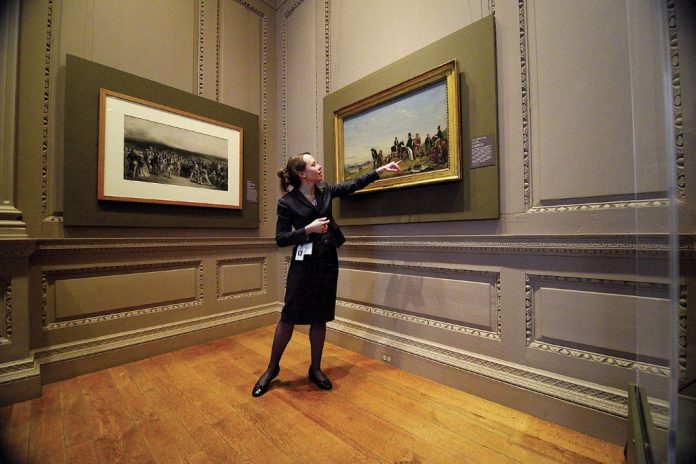The Art Museum of Philadelphia opens an exhibit called The Art of Golf, which will run through July 7th of this year. In addition to famous paintings of golfers, there are displays of traditional coats golfers used to wear in Scotland and England. (Maria Pouchnikova)
When the best golfers in the world gather in Ardmore next month for the 113th U.S. Open, the players, international media and sun-kissed (or rain-drenched) galleries will belatedly commemorate the centennial of a venue steeped in the sport’s illustrious history.
Opened in 1912, the East Course at Merion Golf Club has hosted the Open four times previously, as well as a half-dozen U.S. Amateur events, with legends Bobby Jones, Ben Hogan and Lee Trevino all among the site’s past champions.
But golf is a lot older than venerable Merion.
For an even deeper perspective on the centuries-old pastime, Open patrons need only venture a few miles off the course to the Philadelphia Museum of Art, where an ongoing exhibition explores the game’s Scottish roots. The Art of Golf features about two dozen 19th century paintings, prints and artifacts, all with ties to the world-renowned “home of golf,” the Royal and Ancient Golf Club of St. Andrews, Scotland.
The centerpiece of the display is an 1847 oil on canvas by Charles Lees that curator Jennifer Thompson describes as the definitive golf painting. At seven feet wide and more than four feet high, The Golfers: A Grand Match Played over the Links of St. Andrews offers a panorama of how the game appeared almost 170 years ago.
“Lees has given you the whole panorama of the town itself and the great links land spread around it,” Thompson said during a preview tour of the exhibition.
The term “links” is used to describe a course laid over coastal lands marked by undulating, sandy terrain. The painting depicts an actual four-person match that occurred on the Old Course at St. Andrews three years earlier involving many of the leading golfers of the time. In addition to the players and their caddies, about 50 spectators appear in the frame, many sporting bright red leisure coats, bow ties, top hats and other early Victorian attire.
“[The scene] is thought to have occurred on the fourth hole, which was also known as the Ginger Beer Hole, where you could take a refreshment,” Thompson said. “And one of the details I find particularly charming in the painting is this young girl who is actually offering refreshments, probably ginger beer, to the various spectators.”
Historically, there’s a lot going on in the image. Among the competitors is Sir David Baird, a British baronet and army captain, who is partnered with Sir Ralph Anstruther. One of their opponents is Sir Hugh Playfair, who would serve as provost of the University of St. Andrews for several decades and “was vital to the development of the modern town of St. Andrews,” said Thompson, who attended the university and visited the Old Course many times. Playfair’s partner is John Campbell, one of the elite players of the time.
“I was always amused by this picture because there’s not a hair out of place. It looks like a very calm day,” Thompson said. “And if you’ve been to St. Andrews, you know the wind comes roaring off the North Sea and it is in fact one of the charms of the course, that it’s very challenging. Sometimes, in heavy winds, it’s downright inhospitable to play golf there.”
Although serving as a caddie in the painting, Allan Robertson emerged as perhaps the most notable golfing figure depicted. He became a leading equipment manufacturer and was said to have been unbeaten as a player. Together with his apprentice, Tom Morris, they were known as “the invincibles,” Thompson said.
Morris eventually split with Robertson, left St. Andrews and designed the famous Prestwick course in the west of Scotland, where the British Open — known officially as The Open Championship — was first contested in 1860. “Old” Tom Morris, as he had become known, won the Open four times and eventually returned to St. Andrews as groundskeeper and club professional from 1864 to 1903.
Sir George Reid’s 1903 oil painting of Morris hangs prominently in the ongoing exhibition, while some of Robertson’s equipment is also on display, including a vintage ball made of hardened feathers and a leather cover.
The shiniest object in the collection is a silver club used by the Royal and Ancient Club as a trophy from 1818 until 1930. It was presented annually to the St. Andrews member champion, who would have to commission a new silver golf ball and attach it to the trophy’s shaft.
Sadly, the artifact provides no insight as to the winner of the highly touted match depicted in The Golfers painting. The outcome remains a mystery. Written history of the match in the form of betting slips or other club records also seems to be missing.
“There is no ball from the 1840s that relates to our painting,” Thompson said. “So it’s a circumstance where we’re sort of foiled in knowing who won that particular match.”
The Art of Golf exhibition will continue through July 7 at the Philadelphia Museum of Art and is included in the regular museum admission price. ••
On the Web:
To view a video tour of ‘The Art of Golf,’ visit the Northeast Times’ YouTube page at www.youtube.com/user/NortheastTimes.
Reporter William Kenny can be reached at 215–354–3031 or [email protected]





